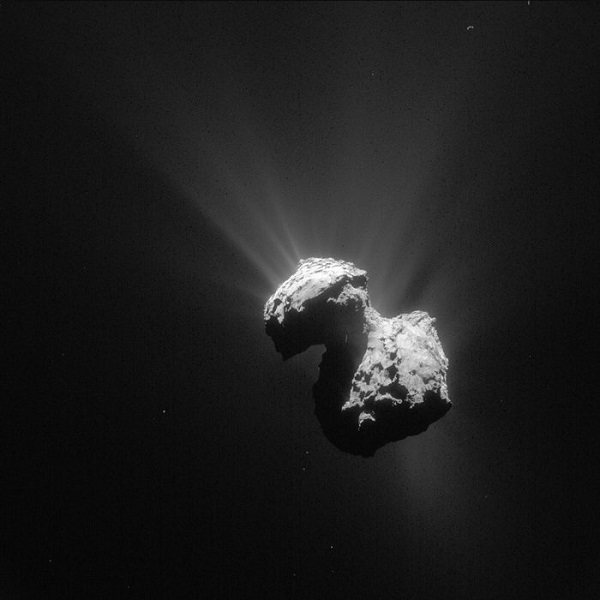When large asteroid 2014 JO25 cruised past Earth on April 19th, Goldstone and Arecibo radars were at the ready.

A series of 30 radar images showing the rotation of asteroid 2014 JO25.
NASA / JPL-Caltech / GSSR
NASA gave us a new view of a small chunk of solar system real estate, and what a strange yet familiar world it is.
Asteroid 2014 JO25 passed 1.1 million miles (1.8 million kilometers) from Earth on April 19, 2017. That's 4.6 times the distance from Earth to the Moon. This pass was the closest of an asteroid 600 meters or larger from Earth since 3-mile wide 4179 Toutatis passed four lunar distances away from Earth in September 2004. This is also the closest 2014 JO25 has come to Earth over the past 400 years.
The close pass provided a great opportunity for amateur and professional telescopes to image the tiny world as it glided through the night sky. It's a thrilling and rare sight to see the tiny dot of an asteroid slowly moving across the starry background in real time at the eyepiece.

Asteroid 2014 JO25, imaged by the Virtual Telescope Project on April 19th (30 second exposure).
Gianluca Masi / The Virtual Telescope Project
NASA also took advantage of the close pass to ping the tiny world with Goldstone and Arecibo radar, pinning down the future three-year orbit for 2014 JO25 to a high degree of precision — a rare feat among the 16,000 known Near-Earth asteroids. The radar images also peg its rotation rate at 4.5 hours.
Prior to this, observations from NEOWISE had suggested an estimated albedo, or reflectivity, of 25% for 2014 JO25 — about twice as bright as the average surface albedo of the Moon. Based on its albedo, astronomers estimated a diameter of 650 meters.
The radar images instead showed that, while the asteroid is indeed about 600 meters across its short axis, the longest part of 2014 JO25 spans a full kilometer, much larger than expected. Though 2014 JO25 passed Earth at a safe distance and poses no threat to humanity Earth in the foreseeable future, this analysis of the asteroid's size serves as a cautionary tale.
Characterizing Asteroid 2014 JO25
NASA used the SpeX spectrograph on its 3-meter Infrared Telescope Facility (IRTF) based at the Mauna Kea, Hawai'i, to classify the asteroid based on absorption features. The result: 2014 JO25 is an S-type “stony” asteroid, similar to what Japan's Hayabusa saw up close to 25143 Itokawa.
The asteroid's twin-lobed, contact binary appearance proved to be the real surprise. It's a cosmic Rorschach Test: Do you see a flying “space peanut,” or a giant rocky rubber duck? While 2014 JO25 spans about a kilometer on its longest axis, a bifurcation between the two lobes dives 200 meters deep. Moreover, that fast 4.5-hour spin ought to be on the verge of flinging the two lobes apart.

Comet 45P/Honda-Mrkos-Pajdušáková, imaged by Arecibo radar during its close pass on February 12, 2017. You can see it has a close twin-lobbed structure as well.
NASA/Arecibo/USRA
Does 2014 JO25 look familiar? The European Space Agency's Rosetta mission just wrapped up its thrilling exploration of 67P/Churyumov-Gerasimenko, a comet four times larger than 2014 JO25 with a strikingly similar "rubber duck" appearance. And Arecibo imaged another twin-lobbed NEO earlier this year: Comet 45P/Honda-Mrkos-Pajdušáková.
All These (Duck-Shaped) Worlds
What gives? Are twin-lobed, near-Earth objects a “thing” in a humorous universe? While these strange worldlets have left planetary scientists scratching their heads, there are a few possible scenarios to consider:
- One is a gentle, low speed collision between two objects — perhaps we're seeing just how planetary accretion might've occurred back in the halcyon days of the solar system's youth.
- Or maybe we're seeing a slow, distended distortion as the asteroid is “spun up” due to what's known as the Yarkovsky-O'Keefe-Radzievskii-Paddack (YORP) effect, as the surface absorbs visible light and re-radiates energy in the infrared.
- A third option is that the asteroid's rubble-pile might have become distorted by an ancient pass near a large planet — 2014 JO25 has passed near both Mercury and Earth.

The bizarre world of Comet 67P, as seen by ESA's Rosetta mission on July 7, 2015.
ESA / Rosetta / NAVCAM
As worlds such as 2014 JO25 change from mere dots of light to real places for exploration, planetary astronomy gives way to planetary geology. Future asteroid missions such as Hayabusa 2 en route to arrive at asteroid 162173 Ryugu in July 2018, NASA's OSIRIS REx currently headed to 101955 Bennu and the Lucy and Psychemissions set to launch in 2021 and 2023 respectively will provide “ground-truthing” for just what worlds such as 2014 JO25 are like, just in case we ever have to attempt to move one out of Earth's way.
Quelle: Sky&Telescope
